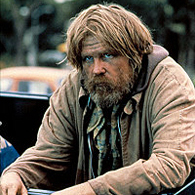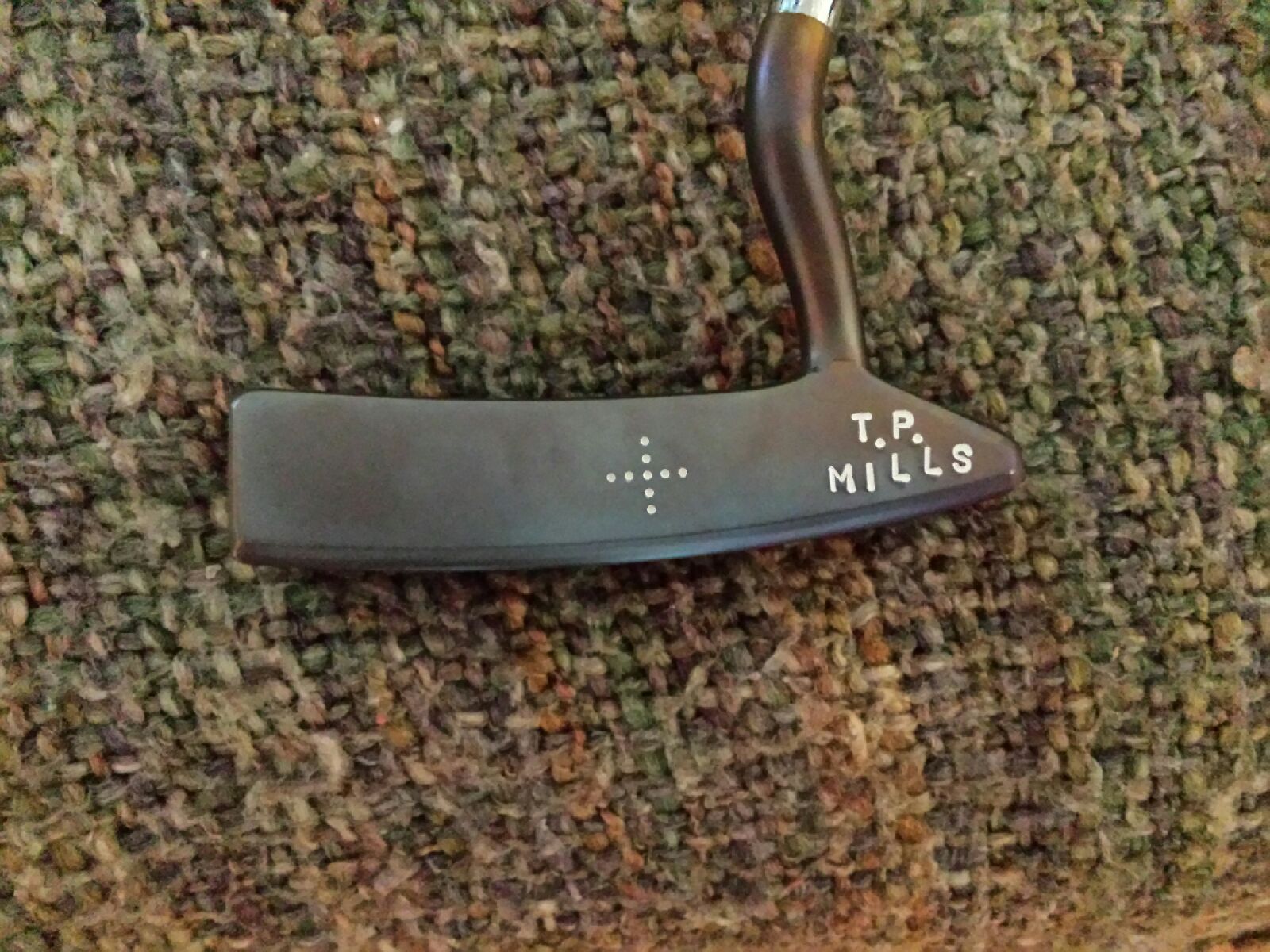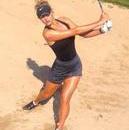-
Posts
90 -
Joined
-
Last visited
About DownAndOut

Personal Information
-
Your Location
UK
Your Golf Game
- Index: 15
- Plays: Righty
Recent Profile Visitors
DownAndOut's Achievements
-

Fat Shots Though Swing Seems Correct
DownAndOut replied to yanni's topic in Instruction and Playing Tips
I've been revisiting this endless belt concept and imho it does seem flawed. If I just imagined I was an adjustable camera that could continue pointing normal to the changing swing plane (ie. formed by the front of the left forearm and clubshaft - left arm flying wedge) from the top of the backswing to impact, the real hand path would look different to these 'face on' views. 1. From the top of the backswing to maybe end of the early downswing (left arm horizontal to the ground, right arm/wrist still still retaining its angles) , the radius of the hand arc would probably be the distance from the hands to the sternum notch. 2. From the end of the early downswing to impact - the right arm would have progressively extended somewhat. Therefore that 'camera' would see a hand arc path whose radius (if we used the sternum notch as the centre of the swing) is getting progressively longer. So if I was that camera , I would see a tighter hand arc radius in the early swing but getting longer into impact which is the complete opposite of what we are seeing from a face-on view (an optical illusion?). Have I got this correct or completely wrong? So is all this theory about 'Aiming Point' flawed from both a geometric and physics perspective? Maybe just learning to sequence the passive unhinging of one's wrists for various types of strokes makes more sense than concentrating on an 'Aiming Point'. -
Pardon me , his full name is Edward A Tischler . I call him Ed as its short for Edward. If TGM is too outdated how about the Tutelman site http://www.tutelman.com/ I forgot to add that if the thread initiator really wanted to delve into the 'Twilight Zone' , there is always Jack Kuykendall website with his alternative views. http://www.kuykendallgolf.com/Members/default.cfm
-
Reading and watching any golf stuff (whether it looks weird, gimmicky or reasonably sensible) is a bit of a hobby of mine. 1. For learning more about biomechanics - Ed Tischler has some good videos on you-tube . He has also published some books on how to perform various tests to determine your own unique biomechanical patterns. Note: Ed doesn't promote any specific swing but basically says you can find a swing that you can own and fits you. 2. If you want to learn a bit more about TGM (Physics and Geometry of the golf swing) all free of charge then I'd go with Dr Jeffrey Mann (http://perfectgolfswingreview.net/index.html and his linked videos). Note that he has now amended some of his original beliefs in TGM and personalised them (so take your choice). Note that Iacus and other more experienced golf instructors may have different opinions of Dr Mann . But whatever one thinks of his overall conclusions (right or wrong) , I think he does a pretty good job explaining some TGM fundamentals without having to spend £100's on Homer Kelley's book (and 100's of hours trying to decipher it). Note : Homer Kelley said there were 450 quadrillion ways to perform a golf action. Note : TGM stuff needs to be revised to take account of more recent technological analysis /data (I don't know what bits of TGM are still correct or outdated now). 3. Another free website where you can learn more about TGM is The Swing Engineer website http://www.theswingengineer.com/imperatives.html 4. An alternative approach is 'Shawn Clements' videos where he uses 'feel analogies' to try and demonstrate how you can get into the correct positions automatically (using G-forces, target focus techniques, external keys , Perpetual Motion Drills , etc ). Note: I think some of his mechanics and anatomical assumptions could be questionable but, imho, the 'feel' stuff is good. The best book I've ever bought that has fantastic illustrations and simple instructions (on how to perform a variety of different strokes) without delving into the detailed mechanics,micro muscle/body moves, physics, geometry , etc was 'PLAY BETTER GOLF' by Beverley Lewis (1990 Coombe Books Ltd). Good luck with your knowledge adventure.
-

How to Perform a Golf Swing Like a PGA Tour Golfer
DownAndOut replied to DownAndOut's topic in Golf Talk
I think I now understand where I'm going wrong with COP variances while COG stable. We have moving masses where the COG is stable , but to slow/stop those masses rotating around that COG , one needs to use the legs to brace and slow them down. To do that brace, one needs to push into the ground (to create bracing shear forces). Therefore , even though the ratios of mass around the COG axis are approximately the same, there can be more vertical force pushing between legs/feet and ground and therefore higher COP values. For some reason , that bit of physics has eluded me until now (I seem to have forgotten that humans have muscles and can jump ) -

How to Perform a Golf Swing Like a PGA Tour Golfer
DownAndOut replied to DownAndOut's topic in Golf Talk
I think his distinction between swinging and hitting is quite blurry now. Dr Mann started with a definite no-go with regards mixing hitting and swinging but then he has slowly introduced options. Plus he has revised some of his original comments. example: 1. You must not cock your right wrist Then It is quite permissible to allow a natural cocking of your right wrist, especially if the arms are moving up a steeper plane than the shoulder plane. 2. You must keep your flying wedges intact. Then It is quite acceptable to palmer flex (bow) your left wrist for stability purposes ( which breaks that intact flying wedge because it moves the clubshaft to a shallower plane than if one hadn't palmer flexed) 3. The left arm is inert and is blasted away from the chest by the active pivot action Then I believe that the lead shoulder girdle muscles can be used to help release PA4 4. You must not use any hittting action with the right arm Then The right arm can be used to synergistically assist the release of PA4 , PA2 and PA3 as long as it doesn't become a dominant factor which would be a 'Hitting' motion. So this means there can be some hit in the swinging motion but within limits (now that is quite a blurry definition). Its like experiment with your swing and find the right amount of swing and hit that doesn't cause timing problems with your swing ( so how does one figure this one out for each and every swing one does on the golf course- each swing will be slightly different depending on your intent?). 5. He talks about a pitch elbow position (in front of the right hip) for swinging while punch elbow (more to the right side) for hitting but there is no mention about how this can be achieved with people who have different upper vs lower arm measurements and differing elbow movements. For example, I cannot pitch my elbow over my right hip by letting it lead in front of the hands , without having to do a major secondary tilt (head over my right foot). 6. Weight Shift - Apparently your COG position is retained up to impact but there are varying COP's depending on the individual golfer (ie. Bubba and others have less COP on their lead leg - rear foot golfers , while many others have significantly more COP on their front foot - front foot golfers). The theory behind this is using data from pressure plates that measure vertical forces but his explanation using ratios of body mass left or right of the COG line (from a face-one view) doesn't make sense. If your COG is in a constant position , then shouldn't there be equal body mass ratios around the central vertical axis through that COG position? When people talk about PRESSURE ,, then isn't that 'FORCE PER UNIT AREA' ? So a high COP doesn't necessarily mean there is more 'mass weight' over that area . It could actually mean the same 'mass weight' applied over a smaller area (ie. maybe on a smaller area of foot contacting the ground). 7. There is no mention of swing anchor positions and their relevant importance during address/setup. For example, when I try and hit balls using the front 'one leg drill' method - I cannot follow-through and fall backwards to keep balance. When I try and hit balls using the rear 'one leg drill' method I am perfectly in balance. With feet together drill I can also just about keep in balance but I do feel more pressure on my rear leg into impact. This sort of proves that I my COG favours pivoting more towards my rear hip and I should set up at address to meet my biomechanical pattern. None of this has been mentioned by Dr Mann yet and I suspect he may have to revise all his papers and state a caveat saying that 'some' of his suggested swing instructions only applies to golfer that have specific biomechanical patterns. That if their elbows, 'hip joints' and wrist hinge movements are like 'this' or 'that' , then 'this' or 'that' specific instruction applies. That should take another 10 years to fully document and analyse by which time my knees, back and hips will be shot to pieces. -
DownAndOut changed their profile photo
-

How to Perform a Golf Swing Like a PGA Tour Golfer
DownAndOut replied to DownAndOut's topic in Golf Talk
Unfortunately , you have to get acquainted with a lot of 'golfing/anatomical/physics' terms otherwise it will be difficult to understand what he's saying. Examples: p positions, flying wedges, hinge, cocking, dorsiflexion, flexion, adduction, abduction, palmer flexion, neutral grip , power accumulators, pronation, supination, circumduction (I think!). Various muscles and bones in the shoulders , pelvis and legs, centrifugal force (although that is a fictitious force), double-pendulum effects (ie. law of the flail) , anatomical flat left wrist, geometrical flat left wrist, base plane line, elbow plane, hand plane, turned shoulder plane, reactive pivots vs active pivots , sweep/early/random/late release , impact zone, drive hold, parametric acceleration, horizontal/diagonal/vertical hinging etc,etc,etc. -

How to Perform a Golf Swing Like a PGA Tour Golfer
DownAndOut replied to DownAndOut's topic in Golf Talk
It was a real real strain to keep my concentration and I suspect I will forget a lot of it within 1 week. -

How to Perform a Golf Swing Like a PGA Tour Golfer
DownAndOut replied to DownAndOut's topic in Golf Talk
Well I've managed to view all the videos a third time and I know for certain I cannot perform the swing because I just don't have the flexibility. Dr Mann mentioned in these videos that he personally has virtually zero pelvic/torso separation (ie, his hips/spine/shoulders turn together almost immediately) and has to find another way (just like me). If a high handicapper was aware of the specific movement necessities required to conduct a particular swing instruction ,and was aware of his/her own inabilities to make that move, wouldn't that save him/her a great deal of wasted time and effort practicing on the wrong moves (that didn't fit their body)? I'm getting closer to identifying my own biomechanical pattern and its definitely going to make it easier for me to pick and choose what type of swing fits me which will not break down in the long term. So it looks like I have 2 swing styles that would fit me because I have difficulty doing a fluent active pivot and keeping my left arm straight. Arm swing (body reacts) - 'tail swings the dog' : 1. Left arm - muscle contraction of left shoulder girdle muscles with a reactive pivot 2. Right arm throwing action with reactive pivot. When I attempt to use an active body pivot to power my arms , my left arm bends, the swing does not feel strain free and my direction is poor (especially with the woods).My distance is superior to techniques 1 and 2 but what's the point if my direction is so inconsistent that the ball gets sent out of bounds or off the fairway into rough/hazards. Its strange because I used to do point 1 (the Lesley King technique) and played quite well , but dumped it because I wanted extra distance. I should have stuck and improved on it 15 years ago but started listening to Leadbetter theories (dog wags the tail ) which was obviously wrong for my inflexible body. -

How to Perform a Golf Swing Like a PGA Tour Golfer
DownAndOut replied to DownAndOut's topic in Golf Talk
I'm not interested in him as a golf instructor but I do like listening/reading different opinions on golf mechanics/biomechanics. You've now got me wondering what he was getting wrong? Is it because he is still quoting TGM stuff that may be outdated and superceded by newer analyses/data? PS. I think he got into trouble for rubbishing Lynn Blakes 'Secret of Golf' and that wet mop idea. Lynn Blake said you had to feel some PP3 pressure point throughout the swing but Mann said that was incorrect because of the forward flex of the clubshaft (if you looked at images of the club bend using a high speed camera). -

How to Perform a Golf Swing Like a PGA Tour Golfer
DownAndOut replied to DownAndOut's topic in Golf Talk
I've never actually tested my swing out to see if it traced the base plane line. I know that Homer Kelley said you need to control the clubshaft, clubhead and clubface. This 'tracing the line' business seems to be something to do with controlling/getting the clubshaft 'On Plane' . So that is 1 of 3 things that must be controlled and (as you've said) will not guarantee a good strike. -

How to Perform a Golf Swing Like a PGA Tour Golfer
DownAndOut replied to DownAndOut's topic in Golf Talk
Isn't this something that Martin Hall suggested (didn't he start promoting that smartstick)? Good luck with your lessons. Will be interesting to see your before and after videos of your swing. -

How to Perform a Golf Swing Like a PGA Tour Golfer
DownAndOut replied to DownAndOut's topic in Golf Talk
Remember that Dr Mann is not a golf teacher who can tell you 'how to' , but I suppose he may be able to advise you 'what to' just using his mechanics/biomechanics assumptions (IF you think they are correct but no-one can claim 100% certainty). In parallel with all of this mechanical stuff, I've just read a book by Dr H A Murray (The Golf Secret) written many many years ago and this statement stuck in my head. "It is because professionals have overlooked the fact that most of the details of the golf swing are subconsciously performed, that they are unable to analyse it accurately or with any degree of unanimity". -

How to Perform a Golf Swing Like a PGA Tour Golfer
DownAndOut replied to DownAndOut's topic in Golf Talk
I've started viewing the whole lot for a third time (onto video 4 now again). But then the weather in the UK is so crap that there is nothing else to do rather than shiver. Wait until you get to the 'Sam Snead Squat' move but you may also need to get acquainted with Power Accumulators and Pressure Points which are explained quite well on his website but maybe even better here (by 'The Swing Engineer' - he and Jeff fell out due to some disagreement about Aiming Point). http://www.theswingengineer.com/power_package.html Plus, to fully understand his anatomical explanation of the pelvic motion, you may need to read his article below http://perfectgolfswingreview.net/pelvicrotation.html -

How to Perform a Golf Swing Like a PGA Tour Golfer
DownAndOut replied to DownAndOut's topic in Golf Talk
From what I have basically gleaned from 15 hours looking at these videos is: 1. Swing intact flying wedges. while: 2. Swinging On Plane (ie, through mostly different inclined planes) - ensuring the 2 ends of the club trace the base plane line while moving through these different inclined planes while 3. Rotating in a barrel plus 4. Learn to keep the clubface perpendicular to the swing plane for at least a few inches post impact. A lot of time is spent explaining different golfing terminologies and anatomical positions plus disagreeing with others about various instruction. In the end the 'how to do it' is : 1. Using a smartstick or lasers to trace along the base plane line. 2. Two handed slapping motion. 3. Underarm pitching throw action 4. Backhand and 2 handed tennis stroke 5. Lead arm Frisbee throw 6. Skipping a stone






